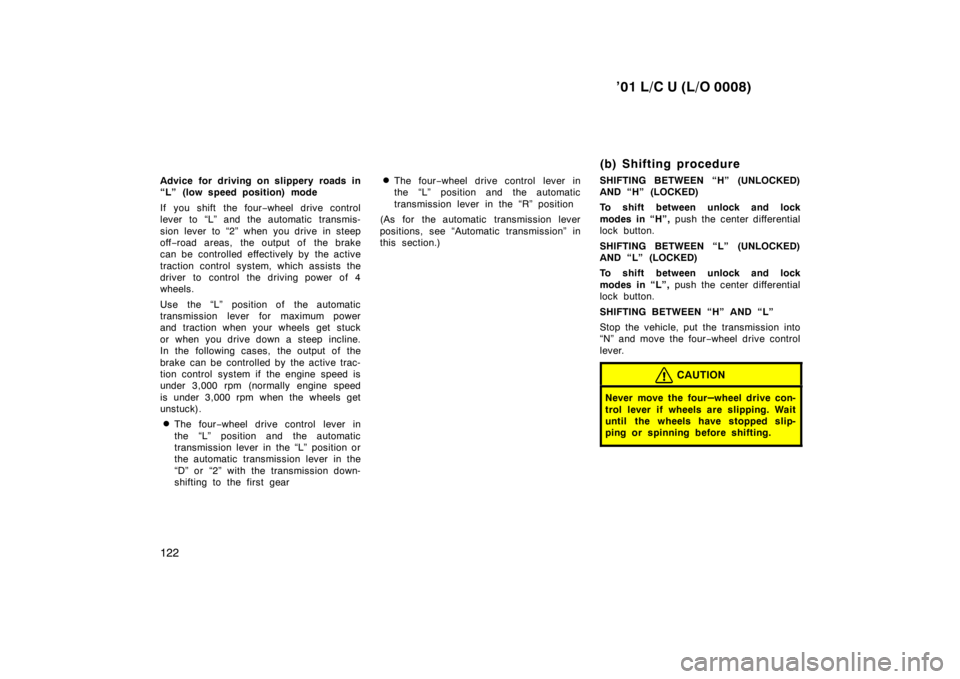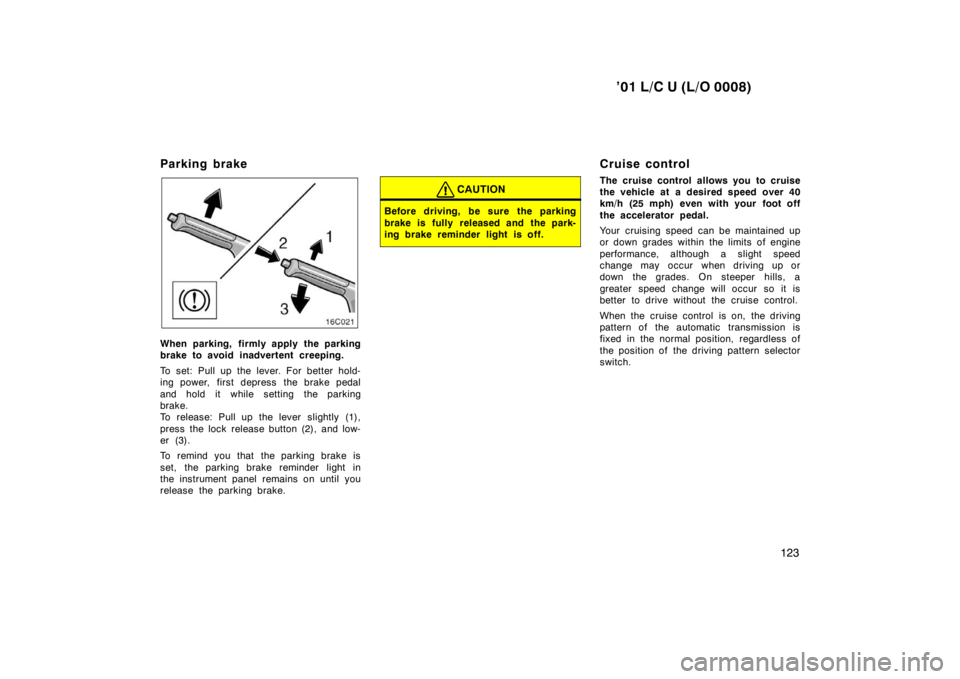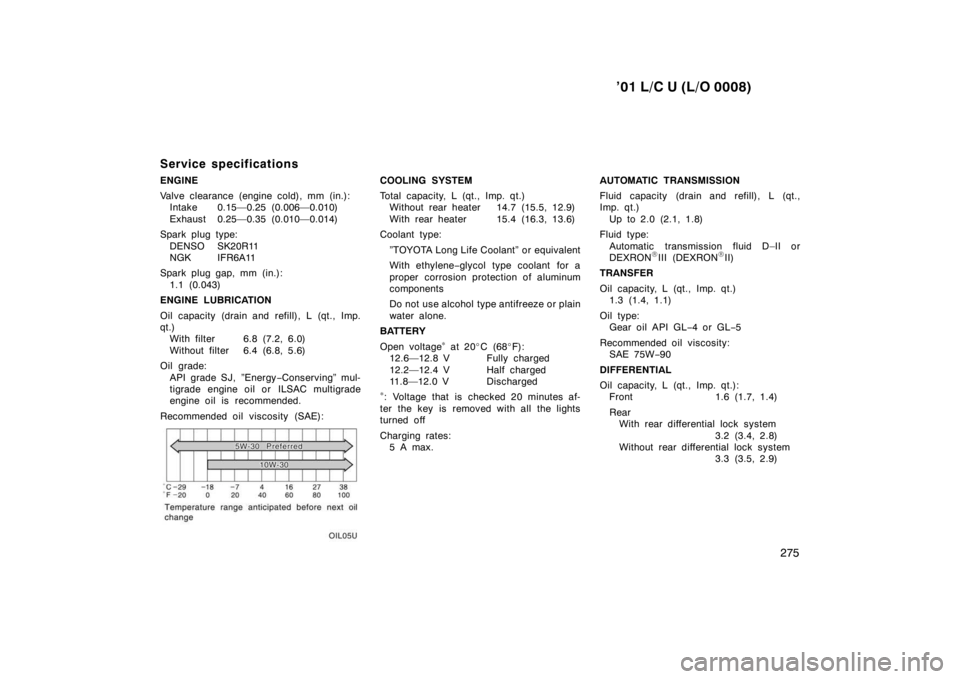2001 TOYOTA LAND CRUISER automatic transmission
[x] Cancel search: automatic transmissionPage 42 of 142

’01 L/C U (L/O 0008)
122
Advice for driving on slippery roads in
“L” (low speed position) mode
If you shift the four
−wheel drive control
lever to “L” and the automatic transmis-
sion lever to “2” when you drive in steep
off −road areas, the output of the brake
can be controlled effectively by the active
traction control system, which assists the
driver to control the driving power of 4
wheels.
Use the “L” position of the automatic
transmission lever for maximum power
and traction when your wheels get stuck
or when you drive down a steep incline.
In the following cases, the output of the
brake can be controlled by the active trac-
tion control system if the engine speed is
under 3,000 rpm (normally engine speed
is under 3,000 rpm when the wheels get
unstuck).
� The four −wheel drive control lever in
the “L” position and the automatic
transmission lever in the “L” position or
the automatic transmission lever in the
“D” or “2” with the transmission down-
shifting to the first gear �
The four −wheel drive control lever in
the “L” position and the automatic
transmission lever in the “R” position
(As for the automatic transmission lever
positions, see “Automatic transmission” in
this section.) (b) Shifting procedure
SHIFTING BETWEEN “H” (UNLOCKED)
AND “H” (LOCKED)
To shift between unlock and lock
modes in “H”,
push the center differential
lock button.
SHIFTING BETWEEN “L” (UNLOCKED)
AND “L” (LOCKED)
To shift between unlock and lock
modes in “L”, push the center differential
lock button.
SHIFTING BETWEEN “H” AND “L”
Stop the vehicle, put the transmission into
“N” and move the four −wheel drive control
lever.
CAUTION
Never move the four –wheel drive con-
trol lever if wheels are slipping. Wait
until the wheels have stopped slip-
ping or spinning before shifting.
Page 43 of 142

’01 L/C U (L/O 0008)123
Parking brake
When parking, firmly apply the parking
brake to avoid inadvertent creeping.
To set: Pull up the lever. For better hold-
ing power, first depress the brake pedal
and hold it while setting the parking
brake.
To release: Pull up the lever slightly (1),
press the lock release button (2), and low-
er (3).
To remind you that the parking brake is
set, the parking brake reminder light in
the instrument panel remains on until you
release the parking brake.
CAUTION
Before driving, be sure the parking
brake is fully released and the park-
ing brake reminder light is off.
Cruise control
The cruise control allows you to cruise
the vehicle at a desired speed over 40
km/h (25 mph) even with your foot off
the accelerator pedal.
Your cruising speed can be maintained up
or down grades within the limits of engine
performance, although a slight speed
change may occur when driving up or
down the grades. On steeper hills, a
greater speed change will occur so it is
better to drive without the cruise control.
When the cruise control is on, the driving
pattern of the automatic transmission is
fixed in the normal position, regardless of
the position of the driving pattern selector
switch.
Page 45 of 142

’01 L/C U (L/O 0008)125
If you need acceleration—for example,
when passing—depress the accelerator
pedal enough for the vehicle to exceed
the set speed. When you release it, the
vehicle will return to the speed set prior
to the acceleration.
CANCELLING THE PRESET SPEED
You can cancel the preset speed by:
a. Pulling the control lever in the ”CANCEL” direction and releasing it.
b. Depressing the brake pedal.
If the vehicle speed falls below about 40
km/h (25 mph), the preset speed will auto-
matically cancel out.
If the vehicle speed drops 16 km/h (10
mph) below the preset speed, the preset
speed will also automatically cancel out.
If the preset speed automatically cancels
out other than for the above cases, have
your vehicle checked by your Toyota deal-
er at the earliest opportunity. RESETTING TO A FASTER SPEED
Push the lever up in the ”RES/ACC” direc-
tion and hold it. Release the lever when
the desired speed is attained. While the
lever is held up, the vehicle will gradually
gain speed.
However, a faster way to reset is to ac-
celerate the vehicle and then push the
control lever down in the ”SET/COAST”
direction.
RESETTING TO A SLOWER SPEED
Push the lever down in the ”SET/COAST”
direction and hold it. Release the lever
when the desired speed is attained. While
the lever is held down, the vehicle speed
will gradually decrease.
However, a faster way to reset is to de-
press the brake pedal and then push the
control lever down in the ”SET/COAST”
direction.
Even if you downshift the transmission by
turning off the overdrive switch, with the
cruise control on, engine braking will not
be applied because the cruise control is
not cancelled. To decrease the vehicle
speed, reset to a slower speed with the
cruise control lever or depress the brake
pedal. If you use the brake pedal, cruise
control is cancelled.RESUMING THE PRESET SPEED
If the preset speed is cancelled by pulling
the control lever or by depressing the
brake pedal, pushing the lever up in the
”RES/ACC” direction will restore the speed
set prior to cancellation.
However, once the vehicle speed falls be-
low about 40 km/h (25 mph), the preset
speed will not be resumed.
CRUISE CONTROL FAILURE WARNING
If the ”CRUISE” indicator light in the
instrument cluster flashes when using the
cruise control, press the ”CRUISE
ON·OFF” button to turn the system off and
then press it again to turn it on.
If any of the following conditions then oc-
curs, there is some trouble in the cruise
control system.
� The indicator light does not come on.
� The indicator light flashes again.
� The indicator light goes out after it
comes on.
If this is the case, contact your Toyota
dealer and have your vehicle inspected.
Page 109 of 142

’01 L/C U (L/O 0008)
238
INSIDE THE VEHICLE
Items listed below should be checked
regularly, e.g. while performing periodic
services, cleaning the vehicle, etc.
Lights
Make sure the headlights, stop lights, tail
lights, turn signal lights, and other lights
are all working. Check headlight aim.
Service reminder indicators and warning
buzzers
Check that all service reminder indicators
and warning buzzers function properly.
Steering wheel
Be alert for changes in steering condition,
such as hard steering or strange noise.
Seats
Check that all front seat controls such as
seat adjusters, seatback recliner, etc. op-
erate smoothly and that all latches lock
securely in any position. Check that the
head restraint move up and down smooth-
ly and that the locks hold securely in any
latched position. For folding
−down rear
seatbacks, swing −up rear seat cushions
and detachable third seats, check that the
latches lock securely. Seat belts
Check that the seat belt system such as
buckles, retractors and anchors operate
properly and smoothly. Make sure the belt
webbing is not cut, frayed, worn or dam-aged.
Accelerator pedal
Check the pedal for smooth operation and
uneven pedal effort or catching.
Brake pedal
Check the pedal for smooth operation and
that the pedal has the proper clearance.
Check the brake booster function.
Brakes
At a safe place, check that the brakes do
not pull to one side when applied.
Parking brake
Check that the lever has the proper travel
and that, on a safe incline, your vehicle
is held securely with only the parking
brake applied.
Automatic transmission ”Park” mecha-
nism
Check the lock release button of the se-
lector lever for proper and smooth opera-
tion. On a safe incline, check that your
vehicle is held securely with the selector
lever in ”P” position and all brakes re-
leased.
IN THE ENGINE COMPARTMENT
Items listed below should be checked
from time to time, e.g. each time when
refueling.
Washer fluid
Make sure there is sufficient fluid in the
tank. See Section 7
−3 for additional in-
formation.
Engine coolant level
Make sure the coolant level is between
the ”FULL” and ”LOW” lines on the see −
through reservoir when the engine is cold.
See Section 7 −2 for additional information.
Battery electrolyte level
Make sure the electrolyte level of all bat-
tery cells is between upper and lower lev-
el lines on the case. Add only distilled
water when replenishing. See Section 7 −3
for additional information.
Page 117 of 142

’01 L/C U (L/O 0008)
246 �
Use only spark plugs of the speci-
fied type. Using other types will
cause engine damage, loss of per-
formance or radio noise.
� Do not reuse iridium −tipped spark
plugs by cleaning or regapping.
� Do not overfill automatic transmis-
sion fluid, transfer oil and power
steering fluid, or the transmission,
transfer and power steering could
be damaged.
� Do not drive with the air cleaner
filter removed, or excessive engine
wear could result. Also backfiring
could cause a fire in the engine
compartment.
� Be careful not to scratch the glass
surface with the wiper frame.
� When closing the engine hood,
check to see that you have not for-
gotten any tools, rags, etc.
Parts and tools
Here is a list of parts and tools you will
need on performing do −it−yourself mainte-
nance. Remember all Toyota parts are de-
signed in metric sizes, so your tools must
be metric.
Checking the engine oil level
Parts (if level is low):
� Engine oil API grade SJ,
”Energy −Conserving” multigrade or
ILSAC multigrade having viscosity
proper for your climate
Tools: � Rag or paper towel
� Funnel (only for adding oil)
Checking the engine coolant level
Parts (if level is low): � ”TOYOTA Long Life Coolant” or equiva-
lent
See Section 7 −2 for details about cool-
ant type selection.
� Demineralized or distilled water
Tools:
� Funnel (only for adding coolant) Checking brake fluid
Parts (if level is low):
� SAE J1703 or FMVSS No.116 DOT 3
brake fluid
Tools:
� Rag or paper towel
� Funnel (only for adding fluid)
Checking power steering fluid
Parts (if level is low):
Automatic transmission fluid DEXRON �
II
or III
Tools:
� Rag or paper towel
� Funnel (only for adding fluid)
Checking battery condition
Tools: � Warm water
� Baking soda
� Grease
� Conventional wrench (for terminal
clamp bolts)
Page 133 of 142

’01 L/C U (L/O 0008)275
Service specifications
ENGINE
Valve clearance (engine cold), mm (in.):
Intake 0.15—0.25 (0.006—0.010)
Exhaust 0.25—0.35 (0.010—0.014)
Spark plug type: DENSO SK20R11
NGK IFR6A11
Spark plug gap, mm (in.): 1.1 (0.043)
ENGINE LUBRICATION
Oil capacity (drain and ref ill), L (qt., Imp.
qt.)
With filter 6.8 (7.2, 6.0)
Without filter 6.4 (6.8, 5.6)
Oil grade: API grade SJ, ”Energy −Conserving” mul-
tigrade engine oil or ILSAC multigrade
engine oil is recommended.
Recommended oil viscosity (SAE):
COOLING SYSTEM
Total capacity, L (qt., Imp. qt.) Without rear heater 14.7 (15.5, 12.9)
With rear heater 15.4 (16.3, 13.6)
Coolant type:
”TOYOTA Long Life Coolant” or equivalent
With ethylene −glycol type coolant for a
proper corrosion protection of aluminum
components
Do not use alcohol type antifreeze or plain
water alone.
BATTERY
Open voltage �
at 20 �C (68 �F):
12.6—12.8 V Fully charged
12.2—12.4 V Half charged
11.8—12.0 V Discharged
� : Voltage that is checked 20 minutes af-
ter the key is removed with all the lights
turned off
Charging rates: 5 A max. AUTOMATIC TRANSMISSION
Fluid capacity (drain and refill), L (qt.,
Imp. qt.)
Up to 2.0 (2.1, 1.8)
Fluid type: Automatic transmission fluid D–II orDEXRON �
III (DEXRON �
II)
TRANSFER
Oil capacity, L (qt., Imp. qt.) 1.3 (1.4, 1.1)
Oil type: Gear oil API GL −4 or GL −5
Recommended oil viscosity: SAE 75W −90
DIFFERENTIAL
Oil capacity, L (qt., Imp. qt.): Front 1.6 (1.7, 1.4) Rear
With rear differential lock system
3.2 (3.4, 2.8)
Without rear differential lock system 3.3 (3.5, 2.9)
Page 134 of 142

’01 L/C U (L/O 0008)
276
Oil type:
Standard differential
Hypoid gear oil API GL −5
Limited −slip differential
Hypoid gear oil for limited −slip differ-
ential API GL −5
Recommended oil viscosity: Above −18 �C (0 �F)
SAE 90
Below −18 �C (0 �F)
SAE 80W or 80W −90
CHASSIS LUBRICATION
Wheel bearings: Lithium base wheel bearing grease,
NLGI No.2
Front drive shaft thrust bushings: Synthetic oil and lithium soap base
chassis grease, NLGI No.1
Propeller shafts: Lithium base wheel bearing grease,
NLGI No.2 BRAKES
Minimum pedal clearance when depressed
with the force of 490 N (50 kgf, 110 lbf)
with the engine running, mm (in.):
116 (4.6)
Pedal free play, mm (in.): 1—6 (0.04—0.24)
Pad wear limit, mm (in.):
1.0 (0.04)
Lining wear limit, mm (in.): 1.0 (0.04)
Parking brake adjustment when pulled with
the force of 196 N (20 kgf, 44 lbf): 4—6 clicks
Fluid type: SAE J1703 or FMVSS No.116 DOT 3
STEERING
Wheel free play: Less than 40 mm (1.6 in.)
Power steering fluid type: Automatic transmission fluid DEXRON �
II
or III Tires
Tire size:
P275/70R16 114S
Tire pressure, kPa (kgf/cm 2
or bar, psi):
Normal driving Front 200 (2.0, 29)
Rear 220 (2.2, 32)
Trailer towing Front 200 (2.0, 29)
Rear 240 (2.4, 35)
Wheel size: 16 � 8JJ
Wheel nut torque, N·m (kgf·m, ft·lbf): 131 (13.4, 96.6)
NOTE: For a complete information on tires (e.g. replacing tires or replacing
wheels), see ”Checking tire pres-
sure” through ”Aluminum wheel
precautions” in Section 7 −2.